What is Selvedge? Simple Guide to Quality Fabric Edges
Ever heard of ‘selvedge’ and wondered what it means, especially for jeans? Selvedge fabric has a special, neat edge that stops it from fraying. It’s a sign of quality. This simple guide will tell you all about it – what it is, how it’s made, how to find it, and why people love it. Let’s learn together!
1. What exactly is “selvedge”?
1.1 The origin of “selvedge”: From “self-edge”
The word “selvedge” is a shorter way to say “self-edge.” This means the edge of the fabric is made by itself, all neat and tidy, while the fabric is being woven on a machine. It’s not cut later and then sewn.
Imagine a ribbon. It has smooth edges that don’t fall apart, right? A selvedge edge is a bit like that, but it’s part of how the whole fabric is made. It’s different from an edge you cut with scissors, which can get messy with loose threads. So, a selvedge edge is woven clean, not cut and then fixed. This self-finished fabric edge is a key feature.
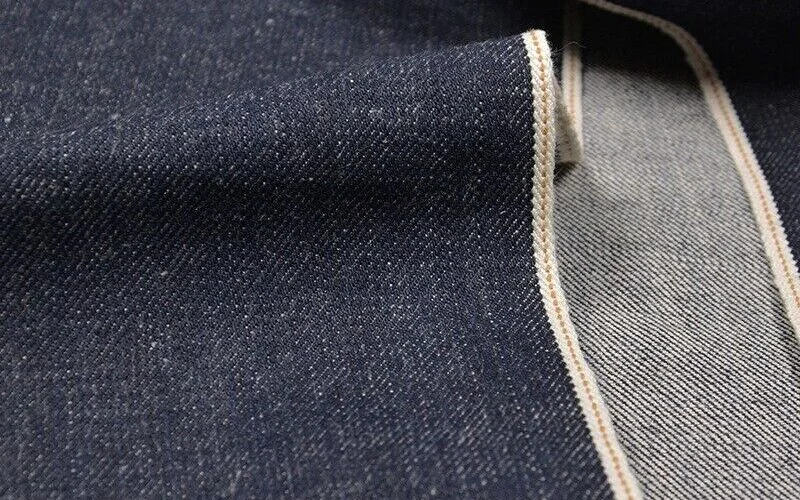
1.2 Why this edge is special
Think about a normal piece of fabric if you cut it. What happens to the edge? Little threads start coming out, and it can look messy. This is called ‘fraying’.
The selvedge edge is special because it is made to not fray. The way it’s woven locks the threads in place at the sides. This non-fraying quality of the fabric edge is very important. It makes the fabric stronger and cleaner at the edges. This is one of the main reasons people value selvedge fabric.
2. How selvedge fabric is made: old-style weaving
2.1 The shuttle loom: a special weaving machine
Selvedge fabric is made using a special, older kind of weaving machine. This machine is called a shuttle loom.
Imagine making fabric. You have threads that go up and down – these are called warp threads. Then, you have threads that go side-to-side, weaving through the up-and-down threads – this is the weft thread.
On a shuttle loom, there’s a little tool called a ‘shuttle’. Think of it like a tiny boat carrying the weft thread. This shuttle travels all the way across the warp threads, from one side to the other. When it gets to the edge, it loops the thread around and goes all the way back across.
It keeps doing this – back and forth, back and forth – with one continuous weft thread. Because the shuttle turns the thread at each side, it neatly locks the edge of the fabric. This creates that clean ‘self-edge’ we talked about. This is a more traditional way of making fabric.
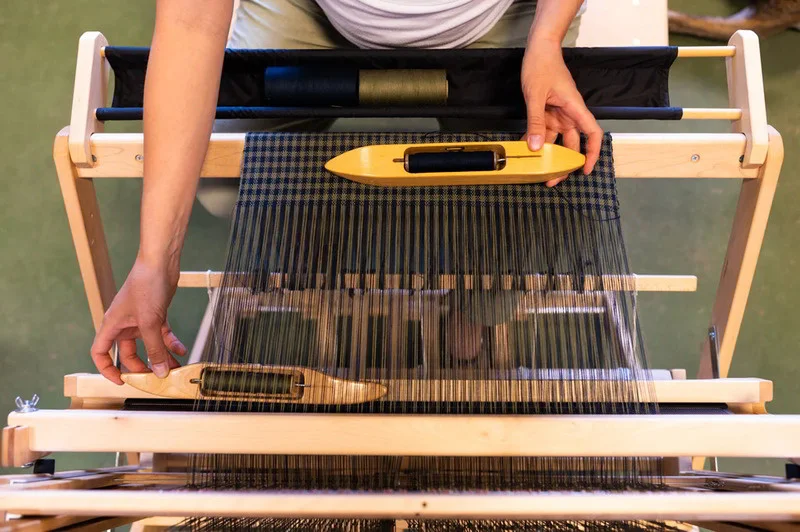
2.2 Slower weaving, stronger edges
Making fabric on these shuttle looms is usually slower than making fabric on big, modern machines. This slower way of weaving often makes the fabric tighter and packed more closely together, making it denser. This isn’t just at the edge, but the whole fabric can feel more solid.
And importantly, it creates a very strong, really solid edge that resists unravelling. Most fabric today is made on super-fast modern machines. These machines usually cut the weft threads at each side of the fabric. Because they cut the threads, they don’t make that special selvedge edge. Those cut edges need to be sewn or finished in some other way to stop fraying.
3. How to spot selvedge fabric
3.1 Look for the clean, finished edge
The easiest way to spot selvedge is to look at the very edge of the fabric. A selvedge edge will look very clean and tidy. It won’t have lots of messy threads sticking out. It won’t look like someone cut the fabric and then sewed over the edge with lots of stitches (like a zig-zag stitch or a thick overlock stitch you often see inside clothes to stop fraying). The selvedge edge is part of the fabric itself, woven right in.
On clothes, especially jeans, a good place to look is on the inside of the outer leg seam. If you fold back the seam, you might see this clean loom-finished edge. Sometimes it’s also used on:
- The inside of a jacket placket.
- The top edge of a back pocket.
At Packlove, we’ve seen brands use the selvedge edge as a design detail in surprising places because it looks so neat!
3.2 The famous selvedge ID stripe
Many times, selvedge edges have a colorful line or stripe woven right into them. This is often called the ‘selvedge ID’ or ‘selvedge identification line’. This stripe is usually on the white or natural-colored part of the selvedge edge.
The most common color you’ll see is red, but it can also be blue, green, yellow, orange, or even gold. Sometimes it’s just a white stripe on a white edge, but you can still see it’s woven in. A long, long time ago, different fabric factories used different colored stripes to mark their own fabric. It was like a signature for them. For example, Cone Mills, a famous American denim maker, often used a red line selvedge for Levi’s.
Today, it’s mostly a cool visual detail that proudly shows the fabric is selvedge. People who like selvedge often love seeing this ID stripe. You often see this ID stripe when people roll up the cuffs of their selvedge jeans.
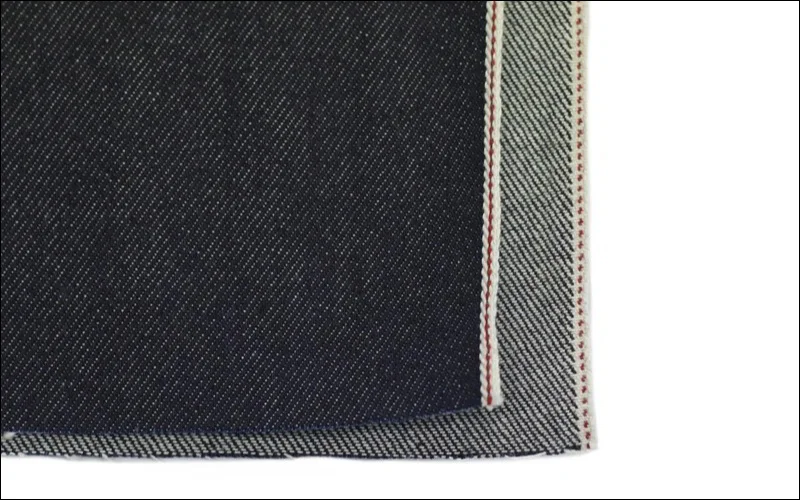
3.3 A clue: narrower fabric
Here’s another clue: selvedge fabric made on those old shuttle looms is usually narrower than fabric made on modern looms. For instance, selvedge denim might be around 30 inches (about 76 cm) wide. Modern denim made on newer machines can be much wider, like 60 inches (about 152 cm) or even more.
This means that to make a pair of jeans from narrower selvedge fabric, the pattern pieces have to be placed carefully. Sometimes it takes a bit more fabric compared to using wider, non-selvedge fabric. This can be one reason why selvedge items sometimes cost a bit more.
4. Why people love selvedge fabric
4.1 It lasts longer: super durable edge
So, why do people get excited about selvedge? The biggest reason is that special edge. It doesn’t fray or fall apart easily. This means that clothes made with durable selvedge fabric, especially where the selvedge edge is used in the seams, can last a very, very long time. The seams stay strong and neat.
Even if selvedge clothes or items cost a bit more to buy, they can be a good deal in the long run because they are so durable and stay looking good for longer. Many people find that their selvedge jeans, for example, hold up incredibly well to lots of wear.
4.2 It shows care and good work (craftsmanship)
Because selvedge fabric is made more slowly on those traditional shuttle looms, many people see it as a sign of good quality and careful work. It feels like someone took extra time and paid more attention to make the fabric well. This idea of craftsmanship is important to those who appreciate selvedge.
So, for many, choosing an item with selvedge fabric is like choosing something that is well-made, with a story behind it. At Packlove, we see this with many brands who choose premium materials; they want every part of their product to reflect that care, right down to the fabric itself.
4.3 It looks good!
Let’s be honest, selvedge can also just look really cool! The selvedge edge itself, especially if it has that colorful ID stripe, can be a neat selvedge design detail. It gives a very clean, tidy, and professional look to the inside of clothes.
And when people roll up their jean cuffs to show off the selvedge edge and its ID stripe, it’s a little style statement. It shows they know about and appreciate this quality detail. It’s a way to say, ‘Hey, look at this cool feature!’

5. Selvedge and denim: a famous pairing
5.1 Why selvedge is a big deal for jeans
When you hear people talking about ‘selvedge’, they are very often talking about selvedge denim, especially for selvedge jeans. Why jeans? Well, many years ago, the original, classic American work jeans were made from selvedge denim. Back then, shuttle looms were the main way to make strong denim fabric.
So, selvedge became known as a sign of tough, high-quality, ‘original recipe’ denim. It was part of what made those old jeans so strong and long-lasting. Today, brands that want to make premium denim – jeans that really focus on tradition, top quality, and durability – will often choose selvedge denim.
From our experience at Packlove, we sometimes work with brands creating high-end denim products, and they often specify selvedge because it signals that level of quality to their customers.
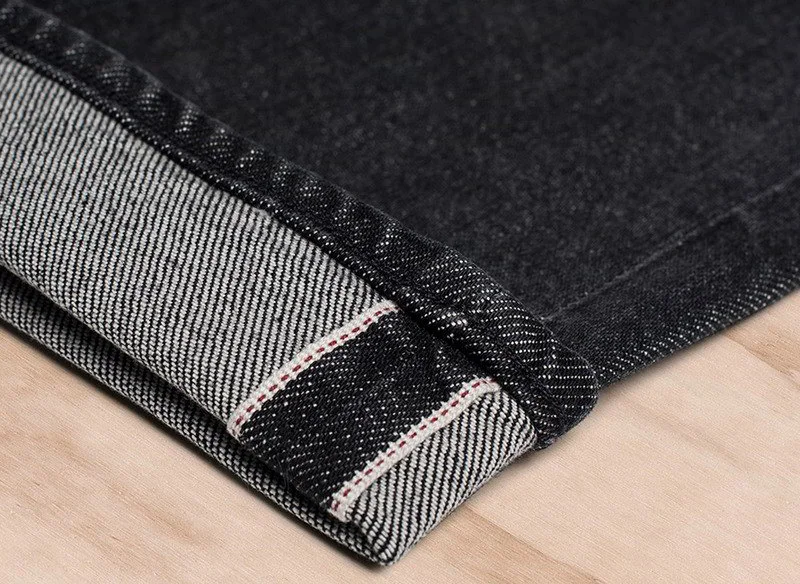
5.2 Selvedge and raw denim often go together
You might also hear the term ‘raw denim’ when people talk about selvedge. In simple terms, raw denim is denim fabric that hasn’t been washed, distressed, or treated in the factory after it’s dyed and woven. It comes to you stiff and dark.
The cool thing about raw denim is that it fades and gets softer over time based on how you personally wear it. You create your own unique fades. Very often, you’ll find that selvedge denim is also raw denim. This is because both selvedge and raw are features that people who love traditional, high-quality, long-lasting denim really appreciate. It’s good to know, though, that you can have selvedge denim that has been washed by the factory. And you can have raw denim that isn’t selvedge. But they are very common partners.
6. Is selvedge only for denim?
No, selvedge is not only for denim, even though denim is definitely where you hear about it the most! Many other types of good quality fabrics can also have a selvedge edge if they are made on those traditional shuttle looms. For example:
- Nice cotton fabrics for shirts.
- Strong selvedge canvas fabric.
- Some wool fabrics for suits or coats.
- Even some linens or silk fabrics.
The important thing is how the fabric is woven, not just what fiber it’s made from.
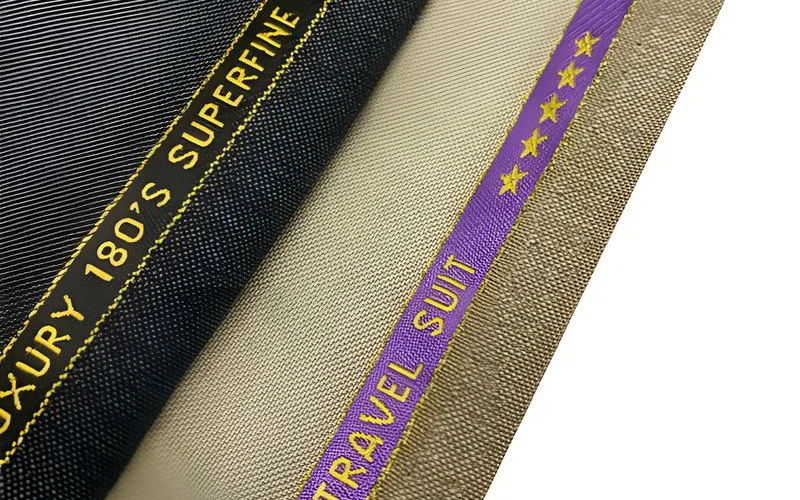
7. Selvedge vs. non-selvedge fabric: what’s the real difference?
So, to make it super clear, let’s put selvedge and non-selvedge fabric side-by-side and see the main differences:
| Feature | Selvedge Fabric | Non-Selvedge Fabric |
|---|---|---|
| The edge | Clean, woven, self-finished. Does not fray. | Cut from wider fabric. Will fray if not finished. Needs sewing (e.g., overlock stitch). |
| How it’s made | On a shuttle loom (older, generally slower). The weft thread loops continuously. | On modern looms (faster, e.g., projectile, rapier, air-jet). Weft threads are cut at each side. |
| Edge strength | Very strong and durable, woven into fabric structure. | Strength depends on how well it’s stitched after cutting. |
| Fabric width | Usually narrower (e.g., denim ~28-32 inches). | Usually much wider (e.g., denim ~58-60+ inches). |
| Cost | Often costs more (slower production, older looms, potentially more fabric needed). | Usually less expensive (faster, efficient machines, wider fabric). |
| Look & feel | Can have a denser feel. Edge is a distinct visual (often with ID stripe). | Quality varies. Edge is cut-and-sewn. |
8. Why knowing about selvedge is cool for you
So, why is it beneficial to know all this information about selvedge?
- Better shopper: it helps you look at clothes and fabrics with new eyes. You can spot a special detail that often means higher quality.
- Understand value: you’ll understand why some clothes (especially jeans) might cost a bit more and why they are often made to last longer.
- Feel knowledgeable: it’s like having a bit of ‘insider info’ about how things are made. You can appreciate the craftsmanship.
- Make smart choices: if you care about durable, well-made items, knowing about selvedge can help you choose things you’ll love for a long time.

9. Finishing touches for quality clothes
Thinking about quality details, like a selvedge edge, reminds us that every part of a garment or product can show how much care went into it.
Just like a selvedge edge gives a neat, durable, and premium finish to the fabric itself, other details like a beautifully designed Woven Label, a soft Heat Transfer Label, or a unique hang tag can give a professional and high-quality finish to your completed clothing item or product. These small things can really show off its quality and your brand’s attention to detail.
At Packlove, we love helping brands create these important finishing touches. We believe that custom labels and tags should match the care and quality of the items they go on, whether it’s selvedge denim jeans or any other thoughtfully made product. From our experience, brands that invest in quality materials like selvedge often want their branding elements to reflect that same level of premium quality. A simple paper tag on a high-end selvedge garment might feel mismatched. That’s where choosing the right label material and design becomes so important, and that’s something we at Packlove can help with.
If you’re creating products that deserve beautiful, quality branding, explore Packlove’s custom label and tag options to find the perfect match.
10. Your selvedge questions answered (FAQs)
10.1 Is selvedge fabric always better?
For really strong edges that don’t fray and a traditional, often higher-quality feel, selvedge is fantastic. But ‘better’ really depends on what you need the fabric for and your budget. Modern non-selvedge fabric can be excellent and is perfect for many uses! Selvedge is a special feature, often for durability and that heritage feel.
10.2 Why are selvedge jeans usually more expensive?
Good question! They often cost more for a few reasons:
- They are slower to make on those special shuttle looms.
- The looms themselves might be rarer or need more skill to operate.
- Selvedge fabric is narrower, so sometimes more fabric is needed to make one pair of jeans.
- They often use high-quality cotton. It’s seen as a premium product.
10.3 How do I wash selvedge jeans, especially if they are raw denim?
Great question, as care is important! Always check the care label on your specific jeans first – that’s the best guide! For raw selvedge denim (unwashed), many fans try to wash them as little as possible, especially at first, to let those unique fades develop. When they do wash, it’s often gently by hand or on a delicate cycle in cold water, inside out, and then air-dried. Avoid hot water and harsh detergents if you want to preserve the dark color longer.
10.4 What does the color of the selvedge ID line (e.g., red, blue) actually mean?
A long time ago, the color of that little stripe was sometimes used by fabric mills to identify their own products or specific fabric qualities. For example, a famous American mill used a red line for Levi’s.
Today, it’s mostly a traditional detail and part of the cool look. There isn’t usually a secret code to the colors anymore that applies to all brands, though some brands might choose specific colors for their own style or to honor a tradition.
10.5 Do all jeans have a selvedge edge?
No, definitely not. Most jeans made today do not have a selvedge edge. Making selvedge denim is a slower, more specialized, and often more expensive process. So, you’ll usually find selvedge edges on more premium, specialty, or heritage-inspired jeans brands. Everyday, mass-market jeans typically use non-selvedge denim with cut-and-sewn edges.
Read more:
We hope this guide helped you understand all about selvedge fabric! It’s a fascinating detail in the world of textiles.
If you’re creating apparel or products and have questions about the best way to brand them with high-quality labels, tags, or packaging that reflects your attention to detail, the team at Packlove is here to help. Contact us today for a friendly chat and expert advice!






















